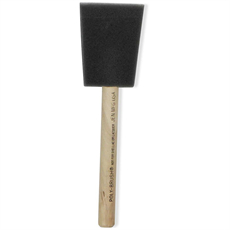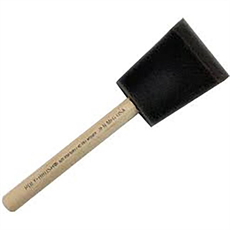Choosing the right paintbrush is a crucial part of any painting project, as it can greatly impact the outcome of your work. There are various types of paintbrushes available, each designed for specific tasks and techniques. Here’s a guide to help you master the art of choosing the right paintbrush:
- Consider the Brush Shape:
- Flat brushes: These brushes have a square edge and are excellent for broad strokes, covering large areas, and creating sharp edges.
- Round brushes: Round brushes have a pointed tip and are versatile for both fine details and broader strokes.
- Filbert brushes: Filbert brushes have a flat, oval-shaped tip, making them suitable for blending and creating softer edges.
- Fan brushes: Fan brushes have flat, spread-out bristles, ideal for creating textures, blending, and special effects like foliage and hair.
- Angled brushes: These brushes have bristles cut at an angle, making them suitable for precise lines and angled strokes.
- Consider the Brush Size:
- Choose a brush size that matches the scale of your artwork. Smaller brushes are suitable for fine details, while larger brushes are better for covering large areas.
- Think about the Bristle Material:
- Natural bristle brushes (usually made from animal hair) are best for oil-based paints, as they can withstand the harsh solvents. They are also suitable for acrylics.
- Synthetic bristle brushes work well with water-based paints like acrylics and watercolors. They are also a cruelty-free option.
- Look at the Brush Type:
- For oil-based paints, use oil brushes designed to handle the thicker consistency of oil paint and withstand solvents.
- Acrylic brushes are specifically designed for acrylic paints, which can be harsh on natural bristles. They have durable synthetic bristles.
- Watercolor brushes are designed with softer bristles for delicate work with watercolor paints.
- Consider the Brush Quality:
- Invest in high-quality brushes if you’re serious about your artwork. They tend to last longer, maintain their shape, and provide better control.
- Lower-quality brushes may shed bristles and deteriorate quickly, resulting in frustration and lower-quality work.
- Think about the Handle:
- Choose a handle length that feels comfortable for your style of painting. Short handles offer more control for close work, while long handles are better for larger canvases and broader strokes.
- Experiment and Practice:
- It’s essential to experiment with different brushes and practice using them to understand their capabilities and limitations.
- Clean and Maintain Brushes:
- Properly clean your brushes after each use to prolong their lifespan. Use appropriate solvents or water for the type of paint you’re using.
- Store brushes upright or hanging to prevent bristle damage.
Ultimately, choosing the right paintbrush comes down to the specific needs of your artwork and your personal preferences. Experimenting with various brush types and sizes will help you develop a better understanding of which brushes work best for your style and medium.














